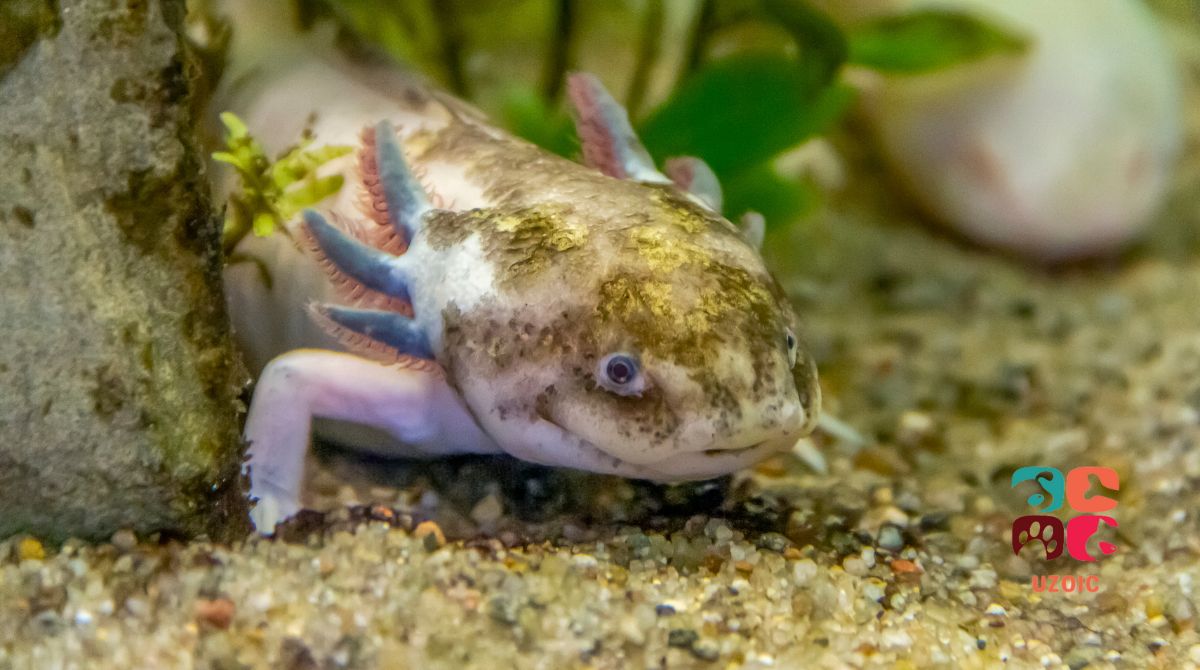Mosaic Axolotls are a stunning and unique type of Axolotl that few people know about. They are highly sought after by aquarium enthusiasts and fish collectors due to their amazing coloring and patterns.
Mosaic Axolotls are a beautiful and unique type of Axolotl native to Mexico. They get their name from their unique coloration, which can be a mix of different colors and patterns. They are usually a mix of brown, black, white, and gold. However, some Mosaic Axolotls can also be blue, green, or even pink!
If you are thinking about getting a Mosaic Axolotl, there are a few things you need to know first. This guide will discuss everything you need to know about Mosaic Axolotls, including their health, breeding, and more!
Table of Contents
What Is A Mosaic Axolotl?
The Mosaic Axolotl is a color morph of the Axolotl, a neotenic salamander that results from cell division errors after the embryos have fused. This means that the genotype (genes) have a defect and do not express correctly, and the phenotype (physical appearance) differs from what was expected. Mosaic axolotls can have any combination of genetic mutations, including changes in color, pattern, and structure. In simple terms, Mosaic Axolotls are axolotls with a genetic defect that gives them their unique appearance.
The most common error is when the animal has two different alleles (varieties) of a gene, but only one is expressed. For example, an axolotl with black and white skin would have the allele for black skin expressed on some cells, while the allele for white skin would be expressed on other cells. As a result, the Axolotl would have a patchwork or “mosaic” appearance. Mosaic axolotls can also occur when an animal has two different sets of chromosomes (one from each parent), but only one set is expressed. These animals are known as “chimeras.”
These mutations can be mild or severe, affecting any or all parts of the Axolotl’s body. While mosaic axolotls are typically healthy, they are often smaller than average and may not live as long as other axolotls.
Mosaic axolotls are very rare and widely sought after by collectors and enthusiasts. Thanks to their unique appearance, they make for interesting and exotic pets.
Mosaic axolotls have patches of skin with no pigment (known as leucism) mixed in with their regular skin coloration. They are sometimes confused with leucistic axolotls, but there is a difference between them. Leucistic axolotls lack all pigment in their skin, while mosaic axolotls still have some pigment. Mosaic axolotls are also sometimes confused with albino axolotls, but again, there is a difference.
As adults, they can reach lengths of up to 12 inches (30 cm). The most notable feature of the mosaic Axolotl is its unique coloration. Rather than being a single solid color, their skin is mottled with black, brown, gold, and white patches. While their coloring is striking, it is also thought to provide excellent camouflage in their natural habitat.
Mosaic axolotls are native to Mexico and can be found in lakes, ponds, and canals in and around Mexico City. They have become popular pets in recent years and are now widely available in the pet trade.
How Do You Get A Mosaic Axolotl?
You can get a mosaic axolotl by contacting a breeder or dealer specializing in axolotls. Mosaic axolotls are a rarer variety of species, so they may be more expensive than other axolotls. Be prepared to provide the breeder or dealer with information about your tank setup and your experience caring for axolotls. They will want to ensure that you are prepared to provide proper care for their animal. Once you have found a reputable source, you can expect to pay anywhere from $1000 to $2000 for a mosaic axolotl.
Are Mosaic Axolotls Rare?
Mosaic Axolotls are a rare type of Axolotl with leucistic and melanistic spots on their bodies. They are the result of a genetic mutation. Mosaic axolotls are popular among breeders and pet owners because of their unique coloration.
Are Mosaic Axolotls Natural?
Mosaic Axolotls are a natural phenomenon. Any axolotl can produce a mosaic axolotl baby since the probability is the same for every Axolotl. The Mosaic axolotl is not a separate species but rather a color mutation of the common Axolotl.
In the wild, axolotls are found in a single color: dark brown or black. However, due to a genetic mutation, some axolotls develop white or light-colored skin patches. While this may seem like a drastic change, it’s actually quite common in the animal kingdom. For example, albino animals occur when there is a complete absence of pigment in the skin. By contrast, leucism results in a partial loss of pigmentation, which can cause a variety of unique color patterns.
As such, mosaic axolotls are uncommon, and their distinctive appearance is entirely natural, so they command a very high price in the pet trade market.
Do Mosaic Axolotls Have Health Issues?
No, mosaic axolotls do not have any known health issues. They live a normal life as an axolotl would, but some reports suggest that they pass on severe genetic defects to their offspring. So this is something that you should consider before purchasing a Mosaic axolotl.
Do Mosaic Axolotls Need Special Care?
Mosaic axolotls are just like any other axolotl and need the same type of care. They should be kept in a tank with clean water and plenty of hiding places. They are carnivores and eat live food, such as worms, insects, and small fish. It is important to provide a varied diet to ensure that they get all the nutrients they need.
As with all axolotls, it is important to avoid handling them too much. They are delicate creatures and can be easily injured. If you must handle them, be sure to do so gently and carefully.
Mosaic axolotls are a beautiful and unique variety of Axolotls that make a great addition to any home aquarium. With proper care, they can live for many years and provide their owners with hours of enjoyment.
How To Breed Mosaic Axolotls!
There are no special requirements for breeding a mosaic axolotl as all Axolotl have an equal chance of producing it. As discussed, Mosaic axolotl is born due to a genetic mutation, and this is something that you cannot force to happen. It is an all-natural phenomenon.
Mosaic Axolotl Color Combinations!
Mosaic axolotls can have a variety of color combinations. The most common is white with black spots, but they can also be yellow, orange, or even pink. Mosaic axolotls are very popular among breeders and pet owners because of their unique coloration.
How Much Is A Mosaic Axolotl?
Mosaic axolotls are very rare, and as such, they command a very high price in the pet trade market. Therefore, you can expect to pay anywhere from $1000 to $2000 for a mosaic axolotl. However, it is important to make sure that you purchase your Mosaic Axolotl from a reputable source.
Marbled Vs. Split Mosaic Axolotls!
Mosaic axolotls come in two varieties: marbled and split. Marbled Mosaic axolotls have a random pattern of leucistic and melanistic spots on their body. Split Mosaic axolotls have a line down the center of their body that separates the two-color patterns. Both types are equally rare and beautiful.
The color spots are evenly distributed throughout the body in the case of marbled axolotls. In contrast, split mosaic axolotls have a distinctive color pattern in which the black and white colors are divided evenly down the center of the body. While both types of mosaic axolotls are equally beautiful, many people prefer the marbled variety because it is more evenly colored.
Vitiligo Vs. Mosaic Axolotls!
There is often confusion between vitiligo and mosaic axolotls. Vitiligo is a condition that results in the loss of pigmentation in the skin. Mosaic axolotls are born with white or light-colored skin patches due to a genetic mutation. As such, vitiligo is not the same as mosaic axolotls.
Mosaic Vs. Chimera Axolotls!
There is often confusion between mosaic and chimera axolotls as well. Many in the axolotl community argue that there is no such thing as a chimera. Chimera is a result of the fusion of zygotes which does not happen in amphibians such as the Axolotl. Mosaic axolotls are born with patches of white or light-colored skin due to a genetic mutation after the fusion of embryos. It is not a hereditary trait. Chimera axolotls have two distinct colorations on their body due to the presence of two different types of cells. As such, chimera axolotls are not the same as mosaic axolotls.
What Causes Mosaic Axolotls?
Mosaic axolotls are the result of a genetic mutation. This mutation occurs spontaneously, and it is not a hereditary trait. All axolotls can produce a mosaic axolotl offspring by a small chance. Mosaic axolotls are often born with brown, gold, white, and black-colored skin patches.
Mosaic axolotls are very rare, and as such, they command a very high price in the pet trade market.
Conclusion
Mosaic axolotls are a stunning and unique variety of Axolotls that make a great addition to any home aquarium. They can live for many years with proper care and provide their owners with hours of enjoyment. If you are considering adding a Mosaic axolotl to your home, be sure to purchase from a reputable source and be prepared to pay a high price. Mosaic axolotls are a true work of art and are well worth the investment. Thanks for reading! I hope this guide was helpful.
You may like:
- 8 Signs Of A Healthy Axolotl
- How Do You Treat A Sick Axolotl?
- Why Are My Axolotls Gills Turning White?
- Do Axolotls Bite? The Truth About Their Biting Behavior


